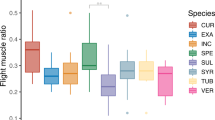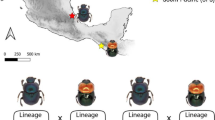Abstract
Non-lethal methods of tissue sampling are increasingly used for genetic studies of insect species and the effects of this approach have long been assumed to be minimal. Tissue removal has the potential to influence insect reproductive behaviours such as mate recognition, courtship or oviposition but the effects of non-lethal sampling on reproductive success have not been widely and adequately tested. Here, we test potential effects of both wing-clipping and leg removal on reproductive behaviours of the cabbage white butterfly (Pieris rapae). We conducted a total of 93 male and 59 female mating trials, and found no significant differences in mating success between treated (i.e., tissue removed) and control individuals in either sex. We also monitored the number and location of eggs laid by 58 females. We found no significant differences in egg-laying behaviour among leg removed and control individuals. Power analysis indicated that we had sufficient statistical power to detect moderate effects of treatment on both mating and oviposition. Our study provides the most comprehensive examination to date of the effects of non-lethal sampling on reproductive behaviours in a butterfly/insect species, and supports the contention that tissue sampling is non-detrimental. To fully comprehend the general impacts of tissue sampling on butterfly reproductive behaviour however, additional similar studies need to be conducted on a variety of species with differing mating behaviours. Only through meta-analysis, may it be possible to detect more subtle effects of tissue removal which cannot be revealed within a single study due to sample size limitations.

Similar content being viewed by others
References
Bergman M, Gotthard K, Wiklund C (2011) Mate acquisition by females in a butterfly: the effects of mating status and age on female mate-locating behaviour. Anim Behav 81:225–229
Boggs CL, Watt WB (1981) Population structure of pierid butterflies IV. Genetic and physiological investment in male offspring by male Colias. Oecologica 50:320–324
Braby MF (2000) Butterflies of Australia: their identification, biology, and distribution. CSIRO Publishing, Collingwood
Brown WD, Alcock J (1991) Hilltopping by red admiral butterflies. J Res Lepid 29:1–10
Cech R, Tudor G (2005) Butterflies of the East Coast. Princeton University Press, Princeton
Châline N, Ratnieks FLW, Raine NE, Badcock NS, Burke T (2004) Non-lethal sampling of honey bee, Apis mellifera, DNA using wing tips. Apidologie 35:311–318
Cohen J (1988) Statistical power analysis for the behavioral sciences, 2nd edn. Lawrence Erlbaum Associates Inc., Hillsdale
Conradt L, Corbet SA, Roper TJ, Bodsworth EJ (2002) Parasitism by the mite Trombidium breei on four UK butterfly species. Ecol Entomol 27:651–659
Crawford L, Desjardins S, Keyghobadi N (2011) Fine-scale genetic structure of an endangered population of the Mormon metalmark butterfly (Apodemia mormo) revealed using AFLPs. Conserv Genet 12:991–1001
Douglas MM, Douglas JM (2005) Butterflies of the Great Lakes region. The University of Michigan Press, Ann Arbor
Faul F, Erdfelder E, Lang A-G, Buchner A (2007) G*Power 3: a flexible statistical power analysis program for the social, behavioural, and biomedical sciences. Behav Res Methods 39:175–191
Fernald CH (1884) The butterflies of Maine. Sprague and Son, New York
Fincke OM, Hadrys H (2001) Unpredictable offspring survivorship in the damselfly, Megaloprepus coerulatus, shapes parental behavior, constrains sexual selection, and challenges traditional fitness estimates. Evolution 55:762–772
Fordyce JA, Nice CC, Forister ML, Shapiro AM (2002) The significance of wing pattern diversity in the Lycaenidae: mate discrimination by two recently diverged species. J Evol Biol 15:871–879
Guppy CA, Shepard JH (2001) Butterflies of British Columbia: including Western Alberta, Southern Yukon, the Alaska Panhandle, Washington, Northern Oregon, Northern Idaho, and Northwestern Montana. University of British Columbia Press, Vancouver
Hamm CA, Aggarwal D, Landis DA (2010) Evaluating the impact of non-lethal DNA sampling on two butterflies, Vanessa cardui and Satyrodes eurydice. J Insect Conserv 14:11–18
Hedenström A, Ellington CP, Wolf TJ (2001) Wing wear, aerodynamics and flight energetics in bumblebees (Bombus terrestris): an experimental study. Funct Ecol 15:417–422
Holehouse KA, Hammond RL, Burke AFG (2003) Non-lethal sampling of DNA from bumblebees for conservation genetics. Insect Soc 50:277–285
Jones RE, Hart JR, Bull GD (1982) Temperature, size and egg production in the cabbage butterfly, Pieris rapae L. Aust J Zool 30:223–232
Kan E, Hidaka T (1997) Role of male scent in the mating behavior of Pieris melete Ménétriès (Lepidoptera: Pieridae). J Ethol 15:87–93
Kemp DJ (2000) Contest behavior in territorial male butterflies: does size matter? Behav Ecol 11:591–596
Kingsolver JG (1999) Experimental analyses of wing size, flight, and survival in the western white butterfly. Evolution 53:1479–1490
Koscinski D, Crawford LA, Keller HA, Keyghobadi N (2011) Effects of different methods of non-lethal sampling on butterflies. Ecol Entomol 36:301–308
Morrow EH, Gage MJG (2000) The evolution of sperm length in moths. P R Soc B 267:307–313
Obara Y, Majerus MEN (2000) Initial mate recognition in the British cabbage butterfly, Pieris rapae rapae. Zool Sci 17:725–730
Pivnick KA, McNeil JN (1985) Mate location and mating-behavior of Thymelicus-lineola (Lepidoptera, Hespriidae). Ann Entomol Soc Am 78:651–656
Pivnick KA, Lavoie-Dornik J, McNeil JN (1992) The role of androconia in the mating behaviour of the European skipper, Thymelicus lineola, and evidence of a male sex pheromone. Physiol Entomol 17:260–268
Renwick JAA, Chew FS (1994) Oviposition behaviour in Lepidoptera. Annu Rev Entomol 39:377–400
Roland J, Keyghobadi N, Fownes S (2000) Alpine Parnassius butterfly dispersal: effects of landscape and population size. Ecology 81:1642–1653
Rutowski RL (2003) Visual ecology of adult butterflies. In: Boggs CL, Watt WB, Ehrlich PR (eds) Butterflies: ecology and evolution taking flight. University of Chicago Press, Chicago, pp 9–26
Scott J (1973) Mating of butterflies. J R Lepidoptera 11:99–127
Scott JA(1986) The butterflies of North America: a natural history and field guide. Stanford University Press, Stanford, USA
Sei M (2009) Flight and oviposition behaviour of the adult maritime ringlet (Coenonympha nipisiquit McDunnough) females in response to microhabitat. J Insect Behav 22:87–100
Shields O (1967) Hilltopping, an ecological study of summit congregation behaviour of butterflies on a southern California hill. J Res Lepid 6:69–178
Starks PT, Peters JM (2002) Semi-nondestructive genetic sampling from live eusocial wasps, Polistes dominulus and Polistes fuscatus. Insec Soc 49:20–22
Stehr FW (1987) Immature insects. Kendall/Hunt Publishing Company, Dubuque, pp 304–305
Svärd L, Wiklund C (1986) Different ejaculate delivery strategies in first versus subsequent matings in the swallowtail butterfly Papilio machaon L. Behav Ecol Sociobiol 18:325–330
Vila M, Auger-Rozenberg MA, Goussard F, Lopez-Vaamonde C (2009) Effect of non-lethal sampling on life-history traits of the protected moth Graellsia isabelae (Lepidoptera: Saturniidae). Ecol Entomol 34:356–362
Williams BL (2002) Conservation genetics, extinction, and taxonomic status: a case history of the regal fritillary. Conserv Biol 16:148–157
Wilson RP, McMahon CR (2006) Measuring devices on wild animals: what constitutes acceptable practice? Front Ecol Environ 4:147–154
Xu J, Wang Q (2009) Male moths undertake both pre- and in-copulation mate choice based upon female age and weight. Behav Ecol Sociobiol 63:801–808
Acknowledgments
The authors thank E. Chan, A. Dang, J. Farhan, J. Favalaro, J. Konopka, A. Marinas, S. Molley, T. Pang, K. Schreiber, and C. Watt for assistance with butterfly rearing, as well as S. Macfie, M. van Hal and A. Wang for providing access to the Western University greenhouses. The authors also thank R. Breckels and B. Rubin who commented on earlier versions of the manuscript. This research was funded by the National Sciences and Engineering Research Council of Canada, the Canada Research Chairs Program and Western University.
Author information
Authors and Affiliations
Corresponding author
Additional information
Lindsay A. Crawford, Daria Koscinski: equal first authorship.
Rights and permissions
About this article
Cite this article
Crawford, L.A., Koscinski, D., Watt, K.M. et al. Mating success and oviposition of a butterfly are not affected by non-lethal tissue sampling. J Insect Conserv 17, 859–864 (2013). https://doi.org/10.1007/s10841-013-9566-8
Received:
Accepted:
Published:
Issue Date:
DOI: https://doi.org/10.1007/s10841-013-9566-8




